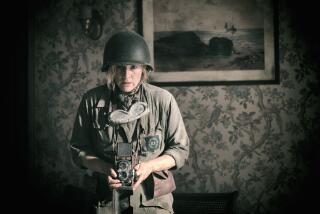Life as we knew it
- Share via
THERE was a sad inevitability to Time Inc.’s announcement that Life magazine will cease publication.
The first American newsmagazine built around photojournalism has lingered in a kind of half-life for the last three years as a weekly color supplement distributed by subscribing to newspapers, including the Los Angeles Times. That was the third incarnation the title had undergone since it stopped independent weekly publication in 1972 to be followed by occasional and, then, monthly issues. No other general interest publication has ridden the wave of popular taste in media for quite so long, but this time the tide was too strongly against it.
The middle ground between pictures that move and still photographs that stand as art has been eroding for some time, and that space in between is where Life always lived.
Paradoxically, the end comes at a time when the visual storytelling that once was the magazine’s franchise innovation has become a ubiquitous cultural property. Digital technology, color reproduction and the unlimited space on newspaper websites have made this something of a golden age for newspaper photojournalism, when the level of ambition and achievement never has been higher.
Life always lived in the moment, and its history is a chronicle of journalism’s adaptation to popular taste. As such, it’s also a rather remarkable list of firsts. We tend to think that the title began in 1936, when Henry Luce launched the country’s first all-photo newsmagazine to accompany Time and Fortune. In fact, Luce acquired a by-then moribund magazine founded in 1883, sold off its subscriber list and gave it a makeover. At its peak, the old magazine was one of the nation’s most celebrated illustrated weeklies, the place where Charles Gibson first drew his celebrated Gibson Girls and where Norman Rockwell got his start.
Luce understood that photography was subsuming illustration as a mass medium and wanted a publication built around that realization. At its launch, his Life was all about celebrity and entertainment, and perhaps because of that the magazine was the first of its era to make a place for a substantial number of female editors and photojournalists. The onrush of history and World War II also pushed Life toward another first of continuing relevance: the blend of hard news with entertainment and cultural news. In the 1950s and early 1960s, science -- particularly exclusive coverage of the manned space program -- was added to the mix, addressing a readership whose educational level had risen on the back of the GI Bill.
Conservative politics was one thing Luce’s Life had in common with its predecessor. Life before 1936 was one of the most virulently anti-Semitic publications ever produced by a mainstream publisher, and vehement anti-unionism was a staple of Luce’s Life.
But in the 1960s, Life’s memorable photojournalism documenting the civil rights movement and the Vietnam War marked an ideological departure also in tune with changing popular sentiment.
Life was a magazine that celebrated celebrity and, in the process, made celebrities of photojournalists and photographers -- iconic names created by iconic images. The list of the magazine’s best-known contributors is one anybody who treasures great visual storytelling is bound to sigh over: Margaret Bourke-White, Alfred Eisenstaedt, Edward Steichen, Gordon Parks, David Douglas Duncan, Henri Huet and the incomparable Robert Capa to name but a few.
To pick just one example from among so many: Duncan’s photos from Vietnam produced one of the most compelling and sobering images of young men at war ever published -- a haunting photo of a monsoon-soaked Marine staring out of his foxhole during the siege of Con Thien. When that picture was collected along with Duncan’s other photos from Southeast Asia in a 1970 volume, “War Without Heroes,” he wrote some text which speaks directly to the democratic instincts that animated so much of Life’s combat photojournalism from the 1930s forward and that made it so influential:
“Every Marine journeyed through each night in his own way, with stops at memories of home, plans for the future and fantasy after fantasy where every chrome-plated deal worked. He lived in the sustaining world of a combat infantryman’s imagination, shielded and reassured by the silent presence of another Marine in the trench beside him, or the next foxhole, whose dreams were probably interchangeable with his own.”
At its peak, Life sold more than 13.5 million copies every week and its photographers came to epitomize a certain romantic notion of the photojournalist as a glamorous, globe-trotting knight errant on a ceaseless quest for pictorial grail, equally at home in a war zone dodging incoming fire as alongside a Parisian runway, snapping the highlights of that spring’s collection. It was such a resonant impression that Alfred Hitchcock made Jimmy Stewart a Life photographer in his classic 1954 film, “Rear Window.” (John Michael Hayes’ great script for that movie was adapted from a Cornell Woolrich novella that was then more than a decade old, which says something about Life’s preeminence throughout that era.) The film’s evocation of emotional claustrophobia often is remarked on, less frequently its profound meditation on the moral distinction between observer and voyeur, which remains a critical issue in the photographic vocation.
It’s difficult to tease either glamour or profundity from an era in which nearly half the country’s teenagers are busily documenting their own lives in a constant stream of images shot and transmitted with cellular telephones.
On the other hand, Life is one of the most resilient titles in the history of American journalism, and it’s hard not to notice that Time Inc. has retained its website.
More to Read
The biggest entertainment stories
Get our big stories about Hollywood, film, television, music, arts, culture and more right in your inbox as soon as they publish.
You may occasionally receive promotional content from the Los Angeles Times.










